light FORD POLICE INTERCEPTOR UTILITY 2014 1.G User Guide
[x] Cancel search | Manufacturer: FORD, Model Year: 2014, Model line: POLICE INTERCEPTOR UTILITY, Model: FORD POLICE INTERCEPTOR UTILITY 2014 1.GPages: 406, PDF Size: 6.86 MB
Page 43 of 406
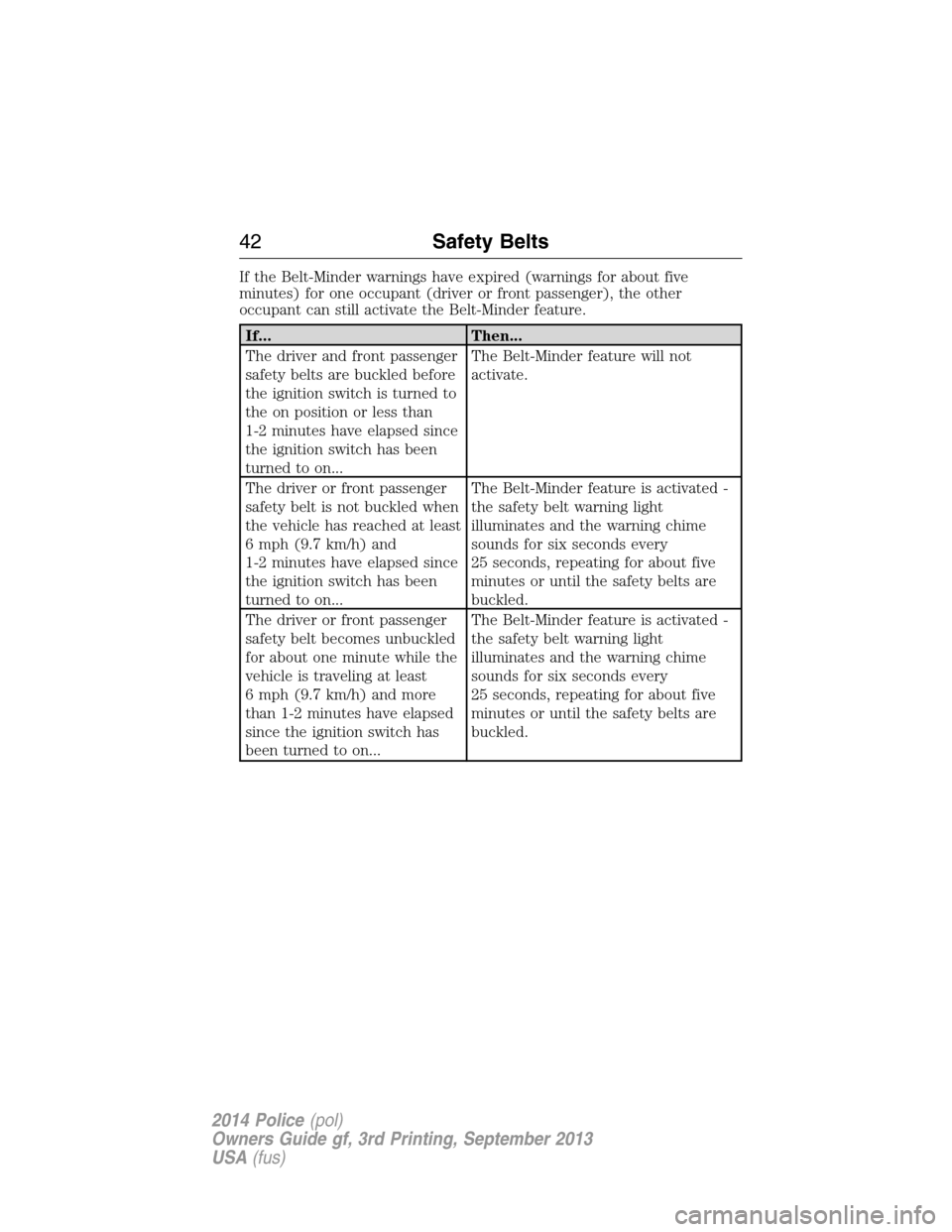
If the Belt-Minder warnings have expired (warnings for about five
minutes) for one occupant (driver or front passenger), the other
occupant can still activate the Belt-Minder feature.
If... Then...
The driver and front passenger
safety belts are buckled before
the ignition switch is turned to
the on position or less than
1-2 minutes have elapsed since
the ignition switch has been
turned to on...The Belt-Minder feature will not
activate.
The driver or front passenger
safety belt is not buckled when
the vehicle has reached at least
6 mph (9.7 km/h) and
1-2 minutes have elapsed since
the ignition switch has been
turned to on...The Belt-Minder feature is activated -
the safety belt warning light
illuminates and the warning chime
sounds for six seconds every
25 seconds, repeating for about five
minutes or until the safety belts are
buckled.
The driver or front passenger
safety belt becomes unbuckled
for about one minute while the
vehicle is traveling at least
6 mph (9.7 km/h) and more
than 1-2 minutes have elapsed
since the ignition switch has
been turned to on...The Belt-Minder feature is activated -
the safety belt warning light
illuminates and the warning chime
sounds for six seconds every
25 seconds, repeating for about five
minutes or until the safety belts are
buckled.
42Safety Belts
2014 Police(pol)
Owners Guide gf, 3rd Printing, September 2013
USA(fus)
Page 44 of 406
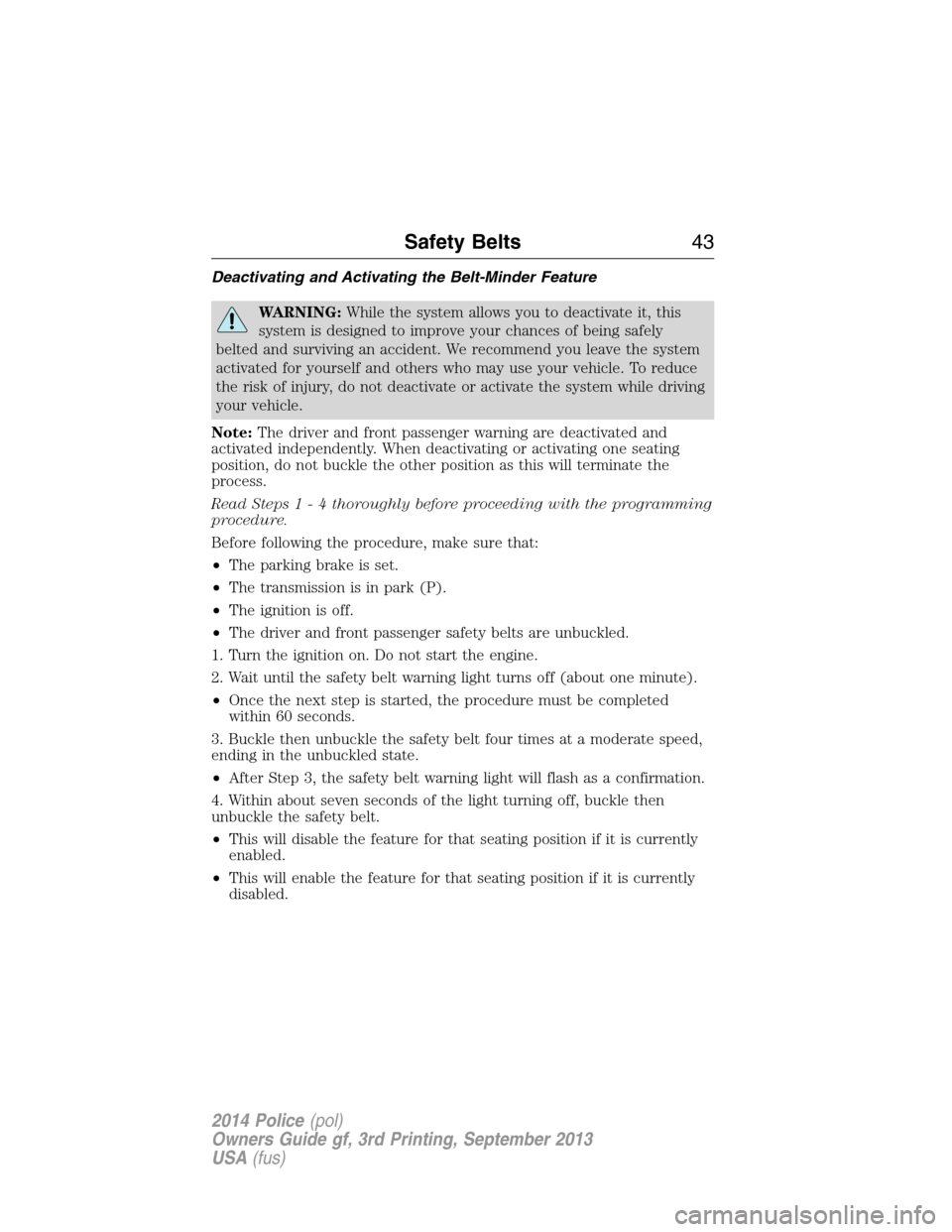
Deactivating and Activating the Belt-Minder Feature
WARNING:While the system allows you to deactivate it, this
system is designed to improve your chances of being safely
belted and surviving an accident. We recommend you leave the system
activated for yourself and others who may use your vehicle. To reduce
the risk of injury, do not deactivate or activate the system while driving
your vehicle.
Note:The driver and front passenger warning are deactivated and
activated independently. When deactivating or activating one seating
position, do not buckle the other position as this will terminate the
process.
Read Steps1-4thoroughly before proceeding with the programming
procedure.
Before following the procedure, make sure that:
•The parking brake is set.
•The transmission is in park (P).
•The ignition is off.
•The driver and front passenger safety belts are unbuckled.
1. Turn the ignition on. Do not start the engine.
2. Wait until the safety belt warning light turns off (about one minute).
•Once the next step is started, the procedure must be completed
within 60 seconds.
3. Buckle then unbuckle the safety belt four times at a moderate speed,
ending in the unbuckled state.
•After Step 3, the safety belt warning light will flash as a confirmation.
4. Within about seven seconds of the light turning off, buckle then
unbuckle the safety belt.
•This will disable the feature for that seating position if it is currently
enabled.
•This will enable the feature for that seating position if it is currently
disabled.
Safety Belts43
2014 Police(pol)
Owners Guide gf, 3rd Printing, September 2013
USA(fus)
Page 46 of 406
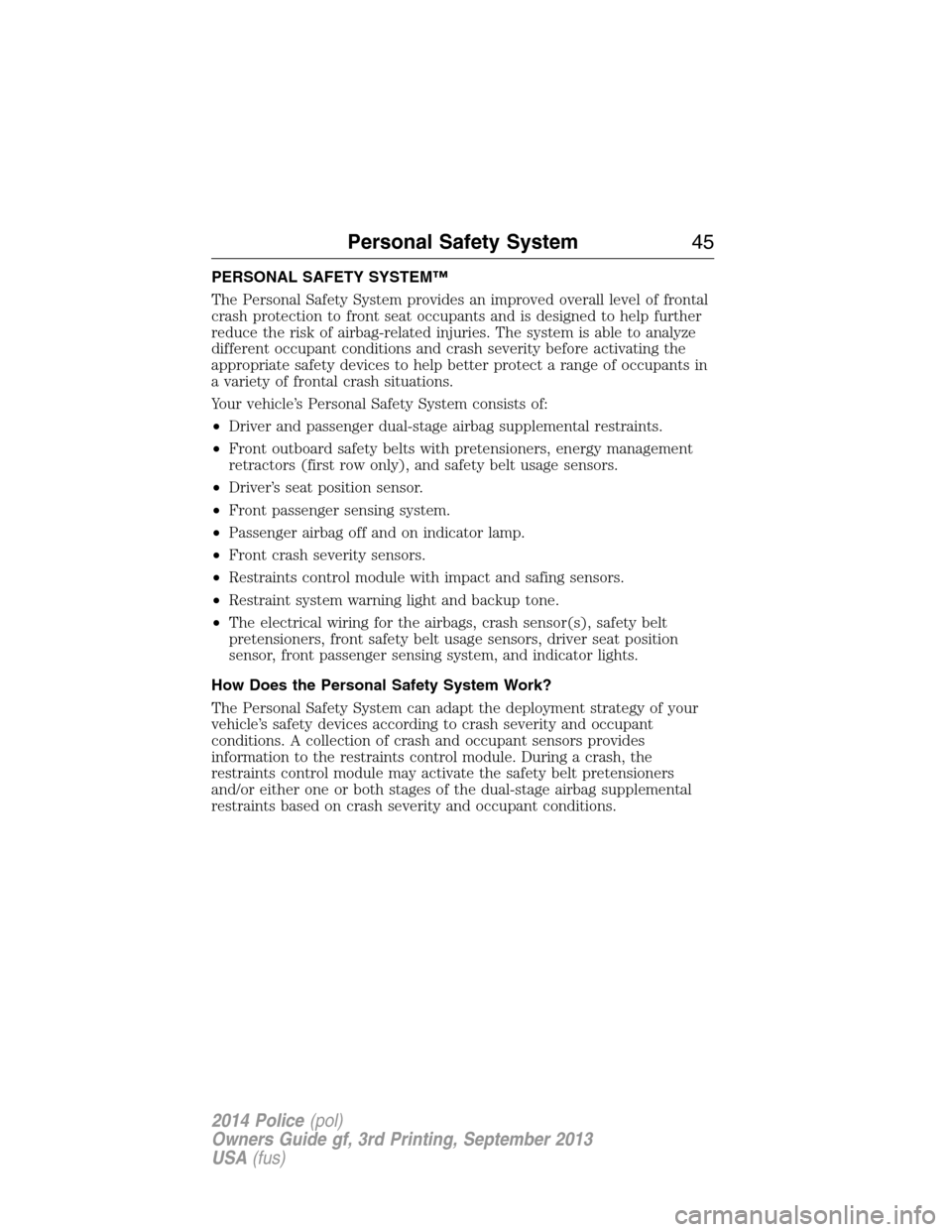
PERSONAL SAFETY SYSTEM™
The Personal Safety System provides an improved overall level of frontal
crash protection to front seat occupants and is designed to help further
reduce the risk of airbag-related injuries. The system is able to analyze
different occupant conditions and crash severity before activating the
appropriate safety devices to help better protect a range of occupants in
a variety of frontal crash situations.
Your vehicle’s Personal Safety System consists of:
•Driver and passenger dual-stage airbag supplemental restraints.
•Front outboard safety belts with pretensioners, energy management
retractors (first row only), and safety belt usage sensors.
•Driver’s seat position sensor.
•Front passenger sensing system.
•Passenger airbag off and on indicator lamp.
•Front crash severity sensors.
•Restraints control module with impact and safing sensors.
•Restraint system warning light and backup tone.
•The electrical wiring for the airbags, crash sensor(s), safety belt
pretensioners, front safety belt usage sensors, driver seat position
sensor, front passenger sensing system, and indicator lights.
How Does the Personal Safety System Work?
The Personal Safety System can adapt the deployment strategy of your
vehicle’s safety devices according to crash severity and occupant
conditions. A collection of crash and occupant sensors provides
information to the restraints control module. During a crash, the
restraints control module may activate the safety belt pretensioners
and/or either one or both stages of the dual-stage airbag supplemental
restraints based on crash severity and occupant conditions.
Personal Safety System45
2014 Police(pol)
Owners Guide gf, 3rd Printing, September 2013
USA(fus)
Page 50 of 406
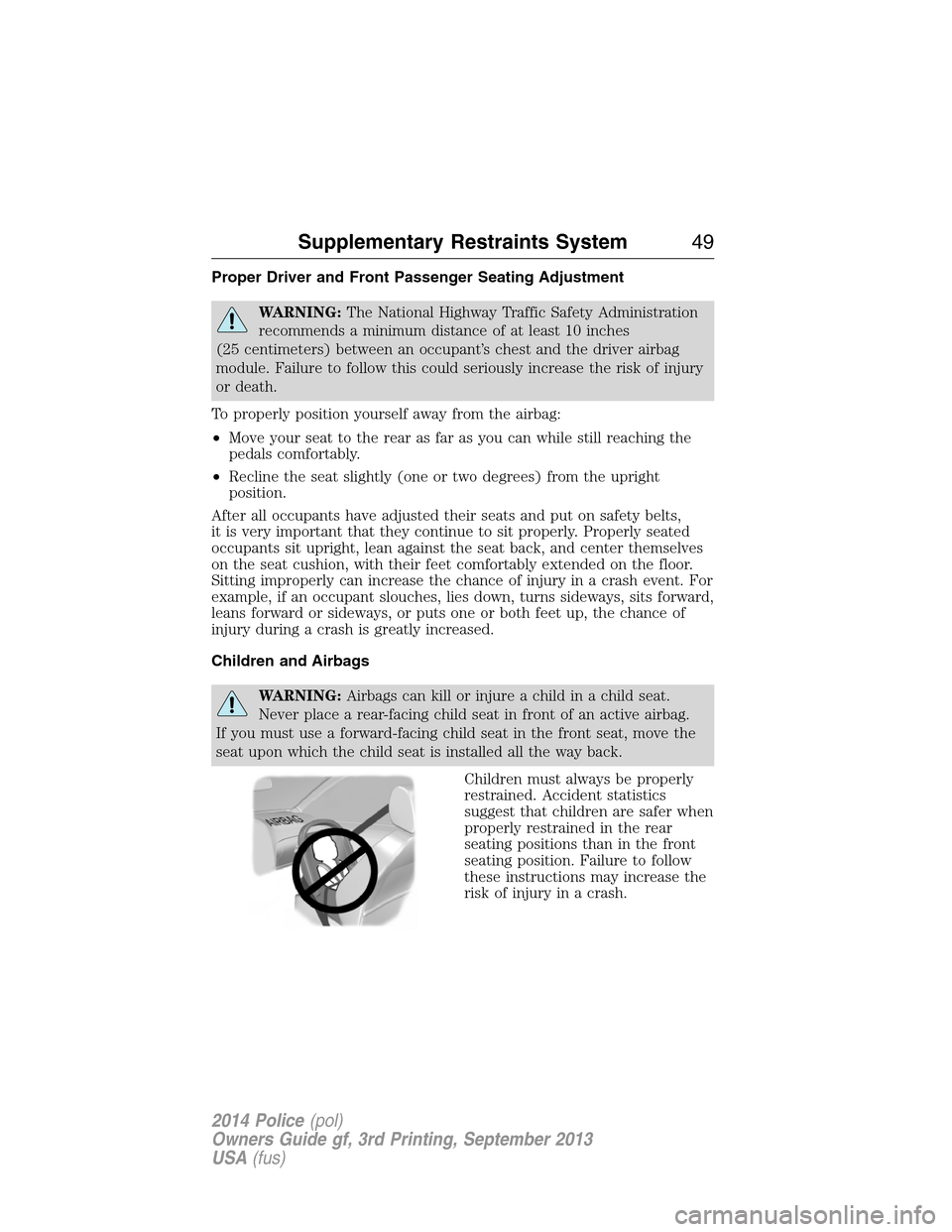
Proper Driver and Front Passenger Seating Adjustment
WARNING:The National Highway Traffic Safety Administration
recommends a minimum distance of at least 10 inches
(25 centimeters) between an occupant’s chest and the driver airbag
module. Failure to follow this could seriously increase the risk of injury
or death.
To properly position yourself away from the airbag:
•Move your seat to the rear as far as you can while still reaching the
pedals comfortably.
•Recline the seat slightly (one or two degrees) from the upright
position.
After all occupants have adjusted their seats and put on safety belts,
it is very important that they continue to sit properly. Properly seated
occupants sit upright, lean against the seat back, and center themselves
on the seat cushion, with their feet comfortably extended on the floor.
Sitting improperly can increase the chance of injury in a crash event. For
example, if an occupant slouches, lies down, turns sideways, sits forward,
leans forward or sideways, or puts one or both feet up, the chance of
injury during a crash is greatly increased.
Children and Airbags
WARNING:Airbags can kill or injure a child in a child seat.
Never place a rear-facing child seat in front of an active airbag.
If you must use a forward-facing child seat in the front seat, move the
seat upon which the child seat is installed all the way back.
Children must always be properly
restrained. Accident statistics
suggest that children are safer when
properly restrained in the rear
seating positions than in the front
seating position. Failure to follow
these instructions may increase the
risk of injury in a crash.
Supplementary Restraints System49
2014 Police(pol)
Owners Guide gf, 3rd Printing, September 2013
USA(fus)
Page 53 of 406
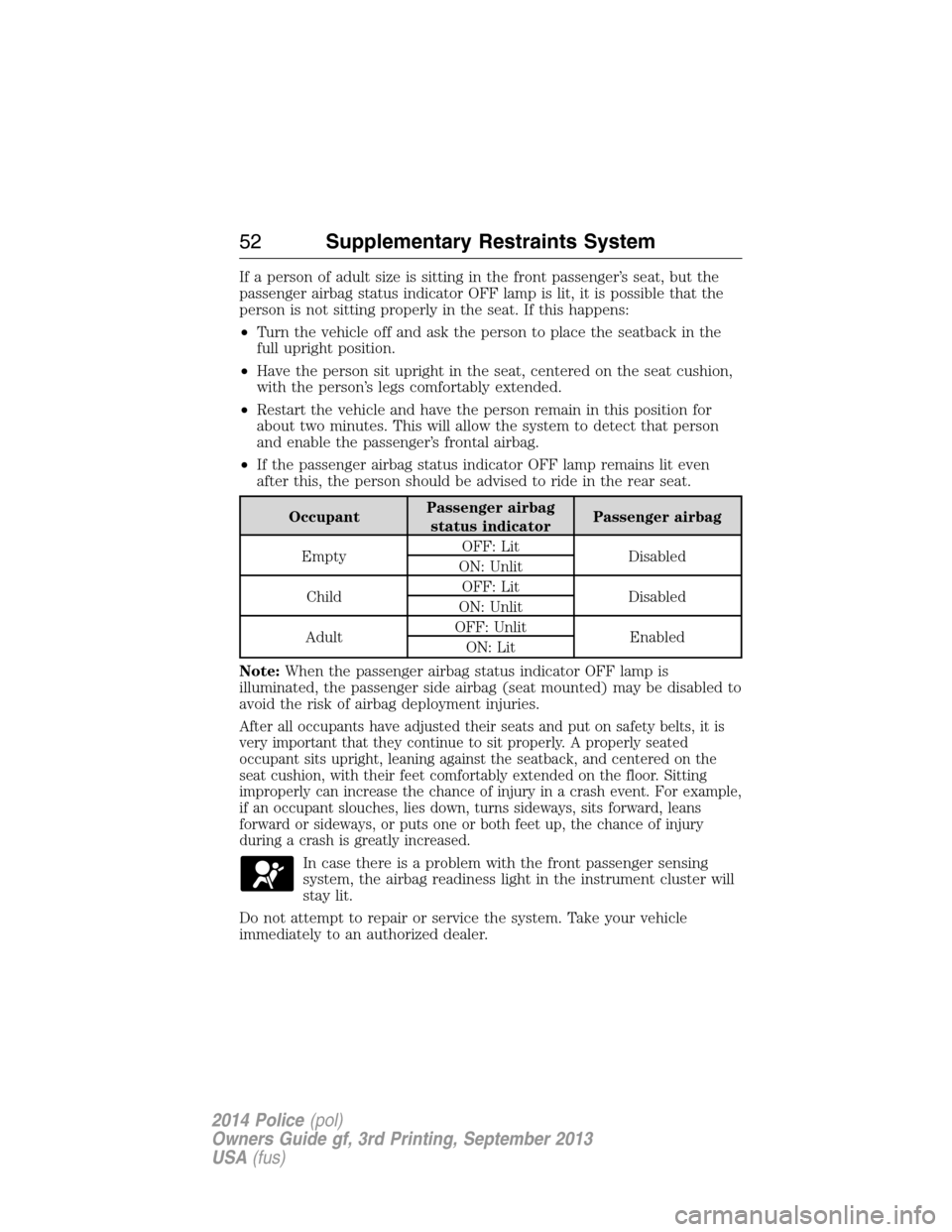
If a person of adult size is sitting in the front passenger’s seat, but the
passenger airbag status indicator OFF lamp is lit, it is possible that the
person is not sitting properly in the seat. If this happens:
•Turn the vehicle off and ask the person to place the seatback in the
full upright position.
•Have the person sit upright in the seat, centered on the seat cushion,
with the person’s legs comfortably extended.
•Restart the vehicle and have the person remain in this position for
about two minutes. This will allow the system to detect that person
and enable the passenger’s frontal airbag.
•If the passenger airbag status indicator OFF lamp remains lit even
after this, the person should be advised to ride in the rear seat.
OccupantPassenger airbag
status indicatorPassenger airbag
EmptyOFF: Lit
Disabled
ON: Unlit
ChildOFF: Lit
Disabled
ON: Unlit
AdultOFF: Unlit
Enabled
ON: Lit
Note:When the passenger airbag status indicator OFF lamp is
illuminated, the passenger side airbag (seat mounted) may be disabled to
avoid the risk of airbag deployment injuries.
After all occupants have adjusted their seats and put on safety belts, it is
very important that they continue to sit properly. A properly seated
occupant sits upright, leaning against the seatback, and centered on the
seat cushion, with their feet comfortably extended on the floor. Sitting
improperly can increase the chance of injury in a crash event. For example,
if an occupant slouches, lies down, turns sideways, sits forward, leans
forward or sideways, or puts one or both feet up, the chance of injury
during a crash is greatly increased.
In case there is a problem with the front passenger sensing
system, the airbag readiness light in the instrument cluster will
stay lit.
Do not attempt to repair or service the system. Take your vehicle
immediately to an authorized dealer.
52Supplementary Restraints System
2014 Police(pol)
Owners Guide gf, 3rd Printing, September 2013
USA(fus)
Page 57 of 406

Children 12 years old and under should always be properly restrained in
the rear seats. The Safety Canopy will not interfere with children
restrained using a properly installed child or booster seat because it is
designed to inflate downward from the headliner above the doors along
the side window opening.
The design and development of the Safety Canopy included
recommended testing procedures that were developed by a group of
automotive safety experts known as the Side Airbag Technical Working
Group. These recommended testing procedures help reduce the risk of
injuries related to the deployment of side airbags (including the Safety
Canopy).
CRASH SENSORS AND AIRBAG INDICATOR
WARNING:Modifying or adding equipment to the front end of
your vehicle (including frame, bumper, front end body structure
and tow hooks) may affect the performance of the airbag system,
increasing the risk of injury. Do not modify the front end of your
vehicle.
Your vehicle has a collection of crash and occupant sensors which
provide information to the restraints control module. The restraints
control module deploys (activates) the front safety belt pretensioners,
driver airbag, passenger airbag, seat mounted side airbags, and the
Safety Canopy. Based on the type of accident (frontal impact, side
impact or rollover) the restraints control module will deploy the
appropriate safety devices.
The restraints control module also monitors the readiness of the above
safety devices plus the crash and occupant sensors. The readiness of the
safety system is indicated by a warning indicator light in the instrument
cluster or by a backup tone if the warning light is not working. See the
Instrument Clusterchapter. Routine maintenance of the airbag is not
required.
A difficulty with the system is indicated by one or more of the following:
•The readiness light will either flash or stay lit.
•The readiness light will not illuminate immediately after the
ignition is turned on.
•A series of five beeps will be heard. The tone pattern will repeat
periodically until the problem or light are repaired.
56Supplementary Restraints System
2014 Police(pol)
Owners Guide gf, 3rd Printing, September 2013
USA(fus)
Page 72 of 406

Opening the Trunk (Sedan Only)
Press the button twice within three seconds to open the trunk.
Make sure the trunk is closed and latched before driving your vehicle.
An unlatched trunk may cause objects to fall out or block the driver’s
rear view.
Smart Locks (If Equipped)
This feature helps to prevent you from locking yourself out of your
vehicle if your key is still in the ignition.
When you open one of the front doors and lock your vehicle with the
power door lock control (on the driver or passenger door trim panel), all
the doors will lock, then all doors will automatically unlock reminding
you that your key is still in the ignition.
Your vehicle can still be locked, with the key in the ignition, by locking
the driver door with a key or using the lock control on the remote
control.
If both front doors and the liftgate are closed, your vehicle can be locked
from any method, regardless of whether the key is in the ignition or not.
Illuminated Entry (If Equipped)
The interior lamps and parking lamps will illuminate when you use the
remote control to unlock the doors or when you open any door.
The illuminated entry system will turn off the lights:
•if you switch the ignition on,
•if you press the remote control lock button,
•after 25 seconds of illumination.
The interior lights will not turn off if:
•you turn them on with the dimmer control, or
•any door is open.
Locks71
2014 Police(pol)
Owners Guide gf, 3rd Printing, September 2013
USA(fus)
Page 76 of 406

Adults should familiarize themselves with the operation and location of
the release handle.
The handle is located inside the
luggage compartment either on the
luggage compartment door (lid) or
near the tail lamps. It is composed
of a material that will glow for hours
in darkness following brief exposure
to ambient light.
Pull the handle and push up on the
luggage compartment door (lid) to
open from within the luggage
compartment.
Locks75
2014 Police(pol)
Owners Guide gf, 3rd Printing, September 2013
USA(fus)
Page 84 of 406
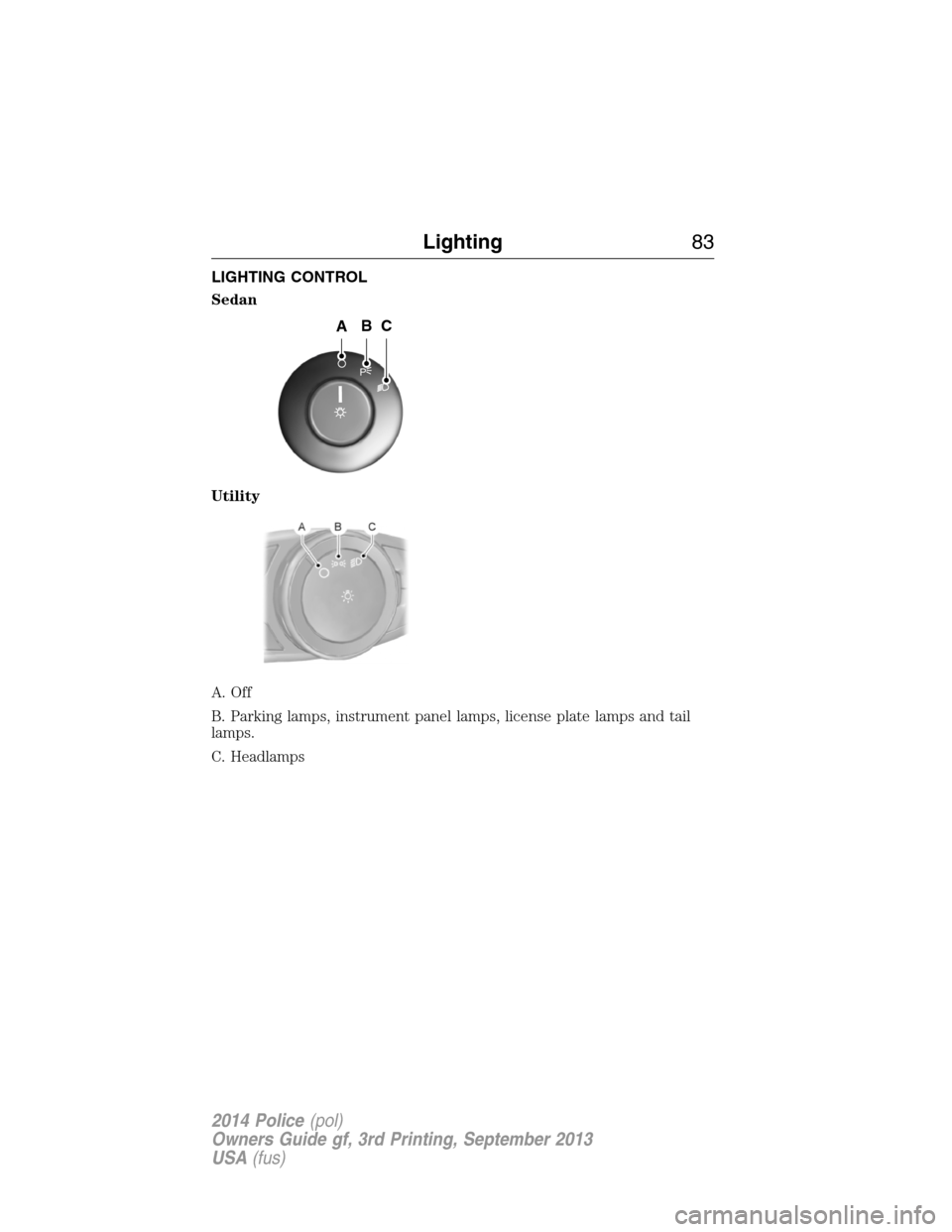
LIGHTING CONTROL
Sedan
Utility
A. Off
B. Parking lamps, instrument panel lamps, license plate lamps and tail
lamps.
C. Headlamps
P
ABC
Lighting83
2014 Police(pol)
Owners Guide gf, 3rd Printing, September 2013
USA(fus)
Page 85 of 406
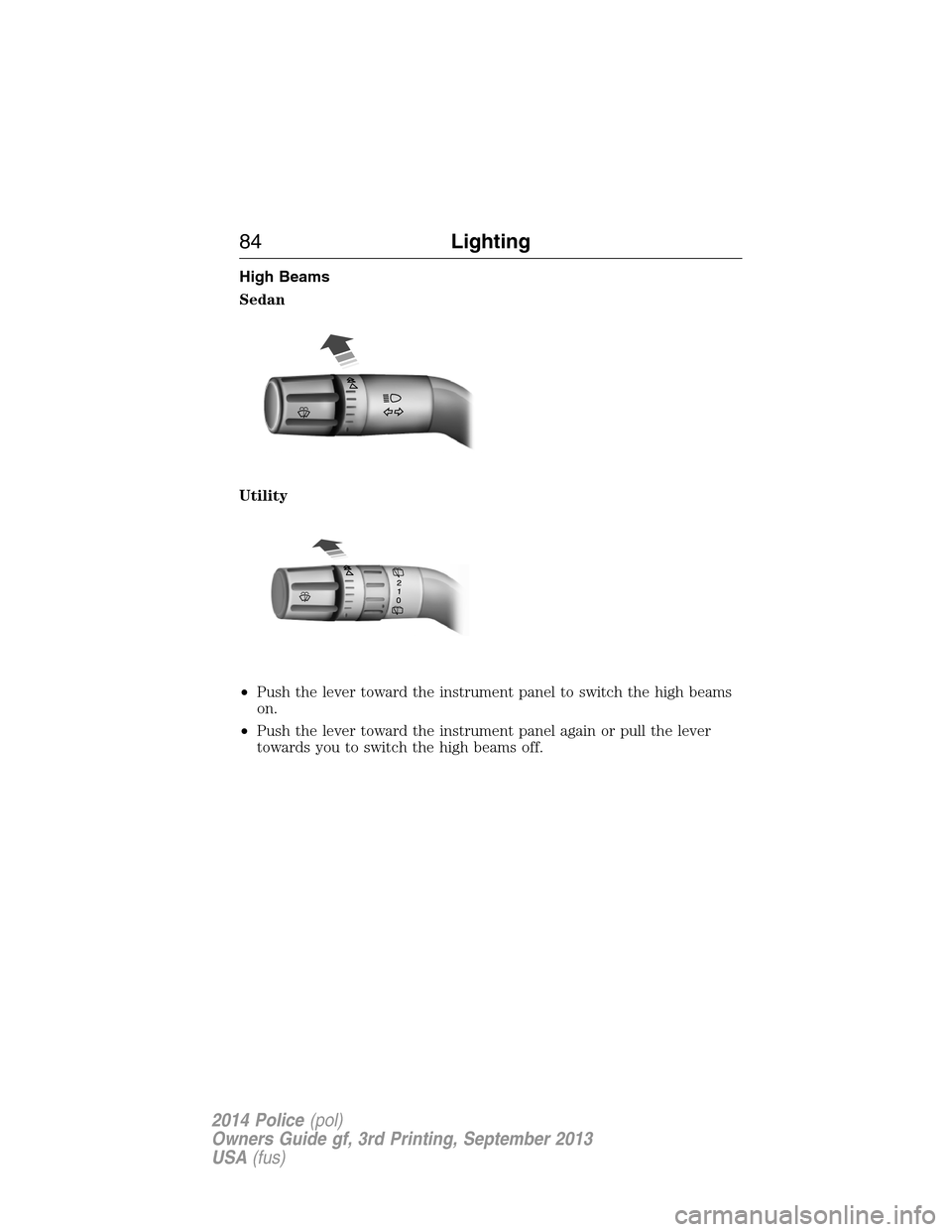
High Beams
Sedan
Utility
•Push the lever toward the instrument panel to switch the high beams
on.
•Push the lever toward the instrument panel again or pull the lever
towards you to switch the high beams off.
84Lighting
2014 Police(pol)
Owners Guide gf, 3rd Printing, September 2013
USA(fus)